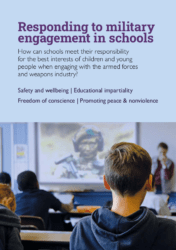Army recruiters visit London’s poorest schools most often
This research published in 2010 has found that the army visited 40% of London schools from September 2008 to April 2009 and disproportionately visits schools in the most disadvantaged areas. The researchers conclude that, “the army’s recruitment activities in schools risk jeopardising the rights and future welfare of the young people contacted.
A report by David Gee and Anna Goodman
The British Regular Army visits schools as a major part of its recruitment programme and a third of new soldier recruits are aged under 18. These recruits may face serious personal risk and challenging moral dilemmas, yet their terms of service can prevent them from leaving the army for up to six years. Given that minors are less able than adults to make free, informed and responsible decisions about enlisting, the UN Committee on the Rights of the Child and the House of Commons/Lords Joint Committee on Human Rights have recommended raising the minimum age of recruitment to 18. Both Committees also recommend that the UK ensure that disadvantaged communities are not targeted for recruitment.
These concerns raise ethical questions about allowing the army to use schools to recruit, particularly those containing students from disadvantaged communities. Focusing on the Greater London area we investigated 1) the proportion of mainstream state secondary schools visited by army recruiters between September 2008 and April 2009 and 2) how this proportion varied by school socio-economic disadvantage, measured using the percentage of pupils eligible for free school meals. We found that army recruiters visited 40% of schools. Army recruiters were particularly likely to visit the most disadvantaged schools: 51% in the most disadvantaged fifth were visited vs. 29% in the middle fifth and 40% of schools in the richest fifth (p=0.01).
The authors believe the large proportion of army visits to schools, particularly the most disadvantaged, may put minors at risk and merits wider debate.

